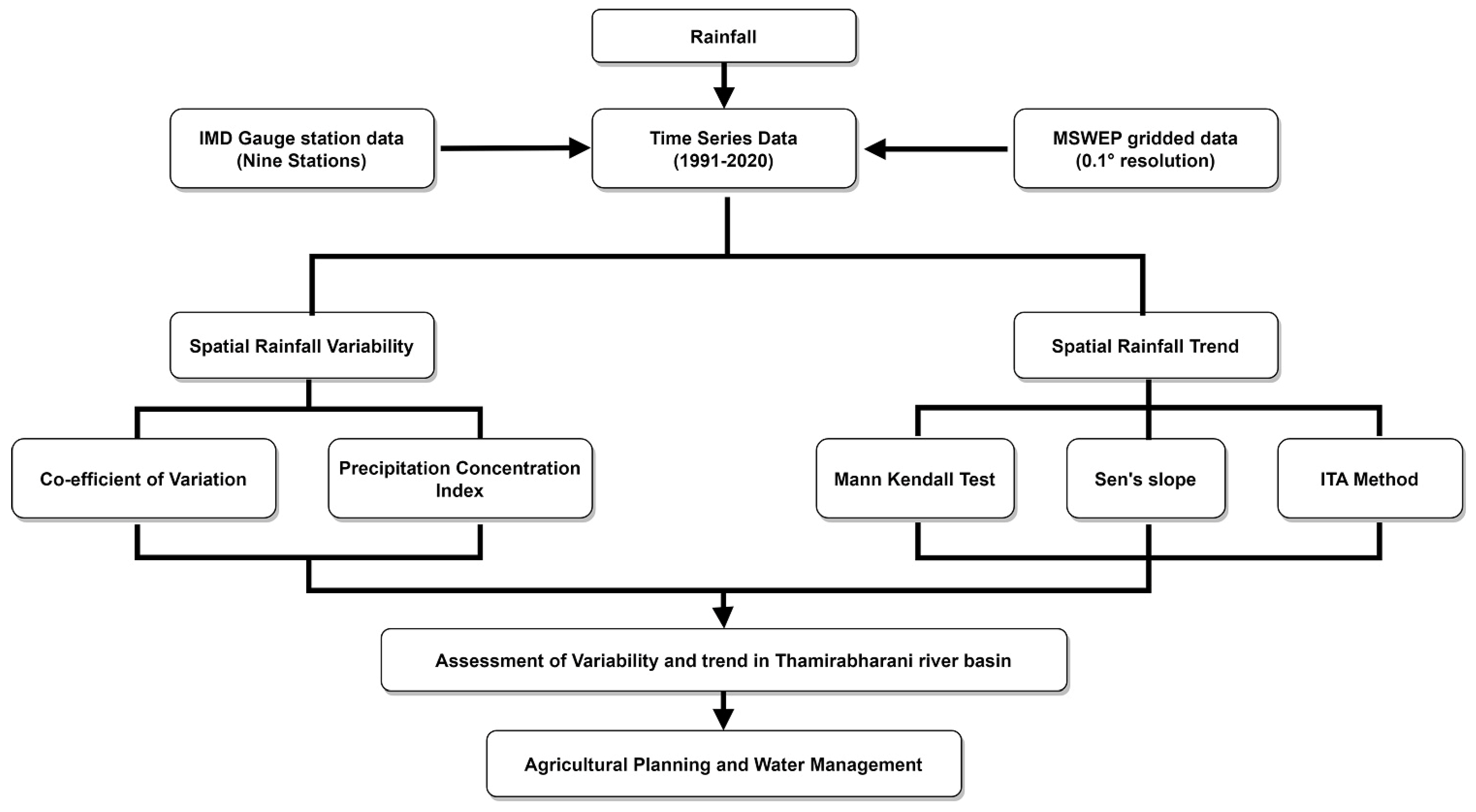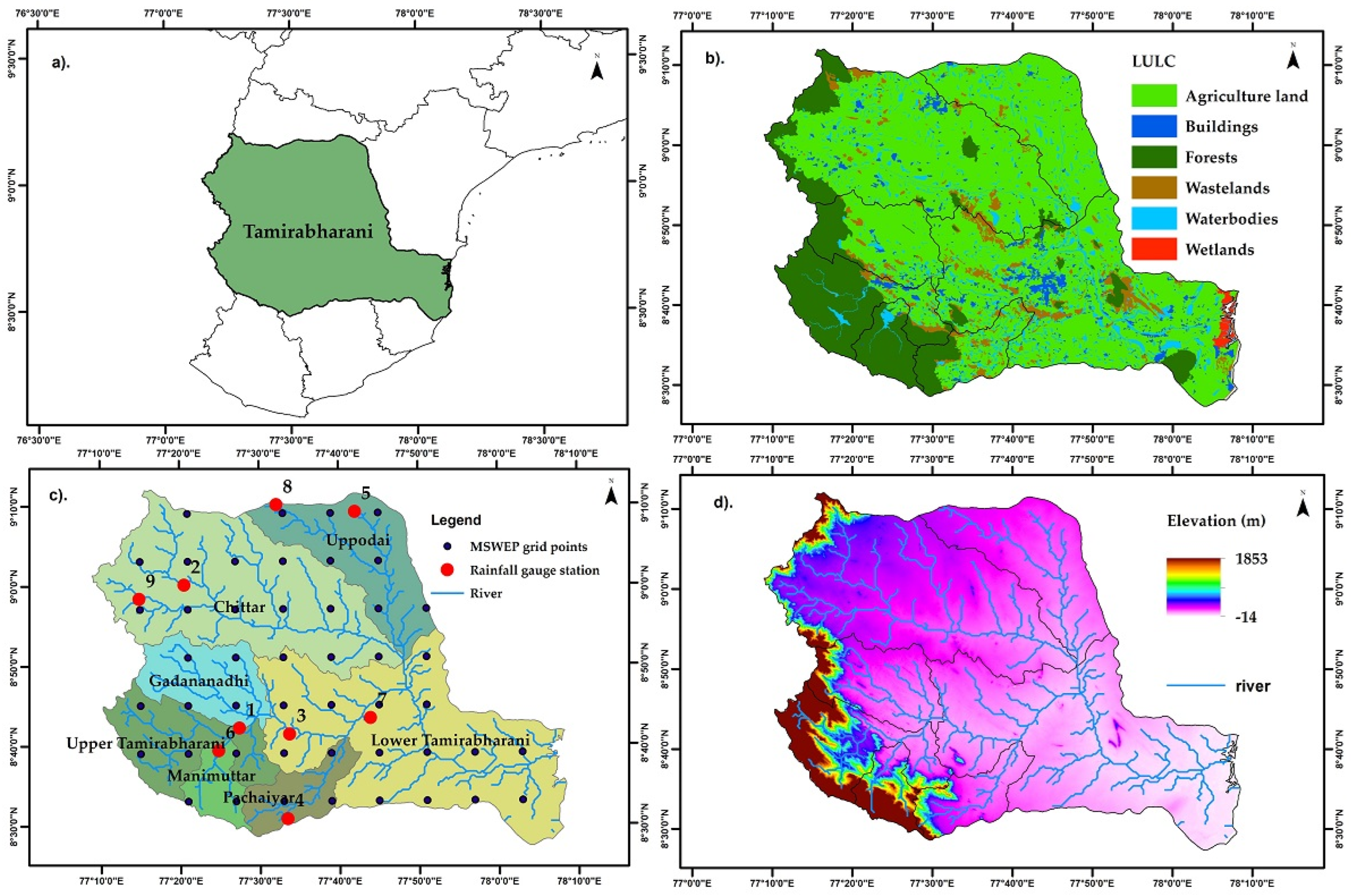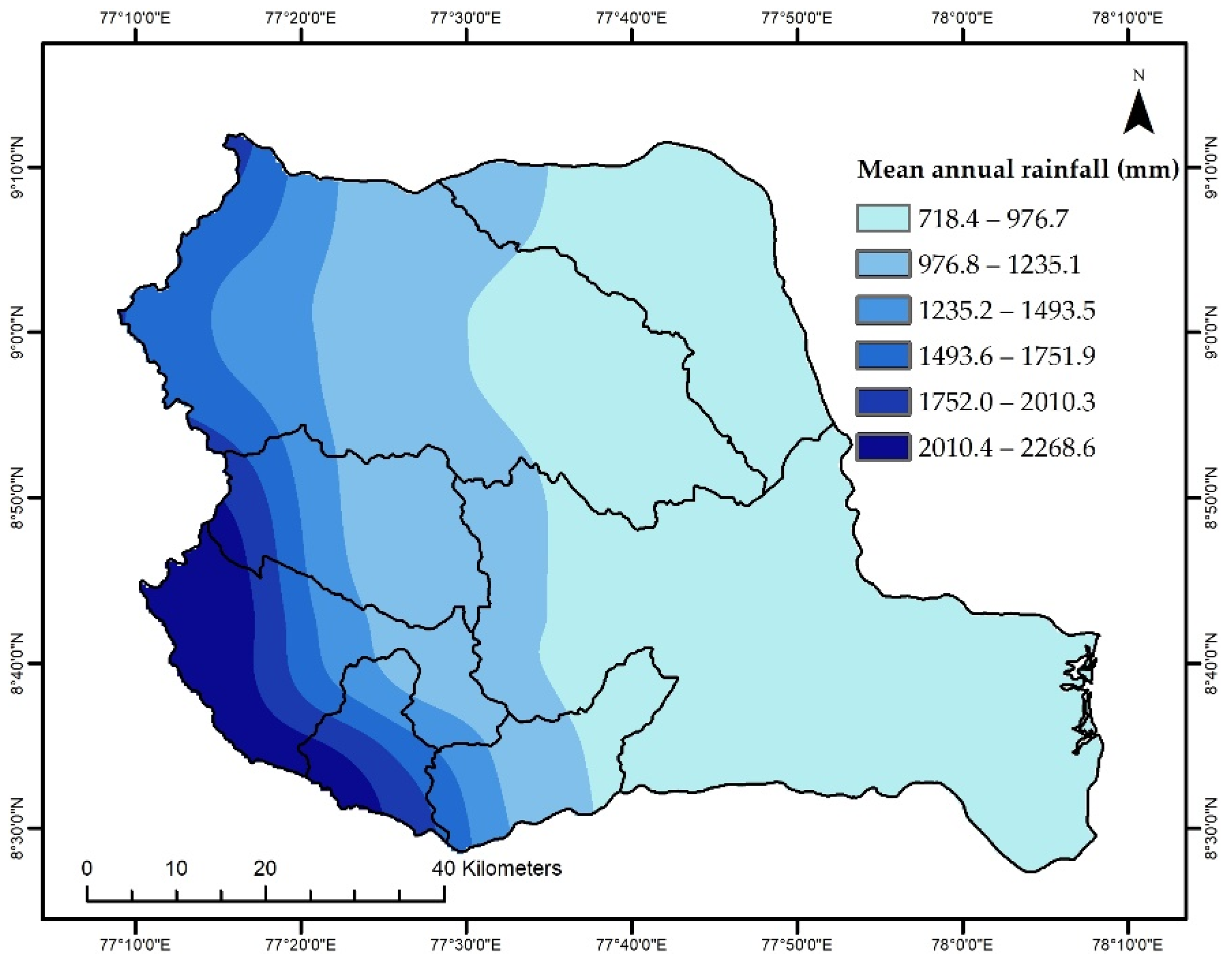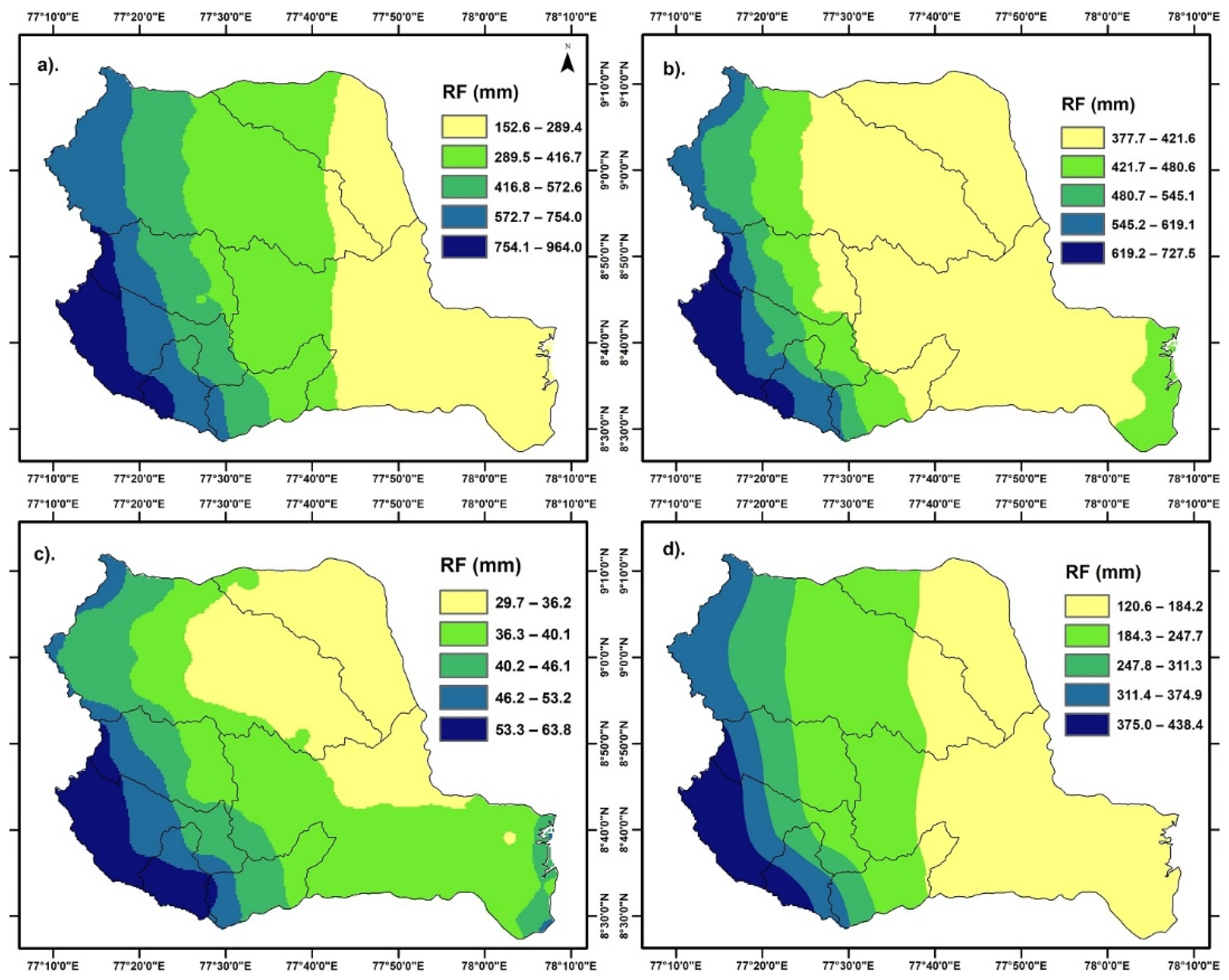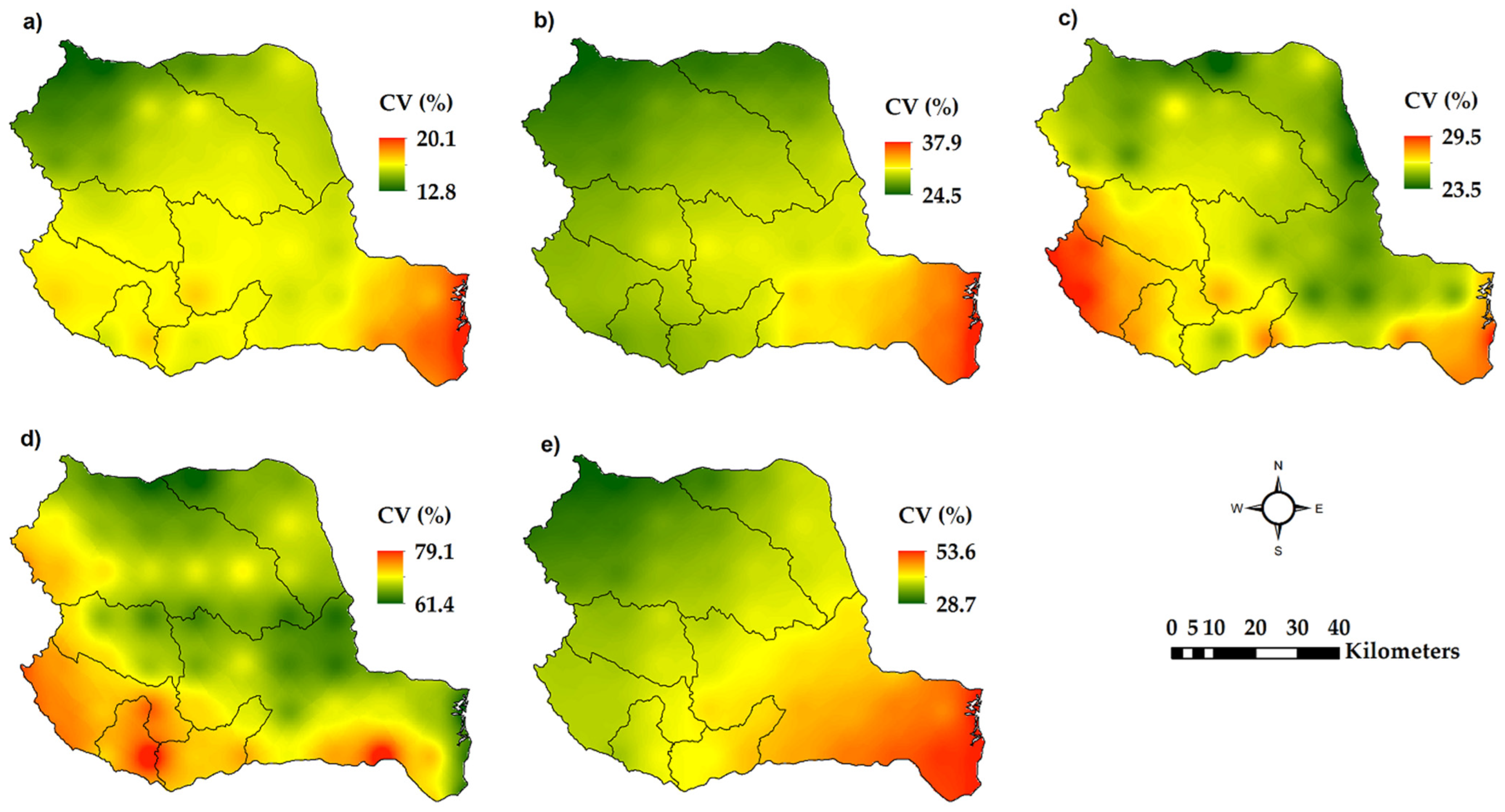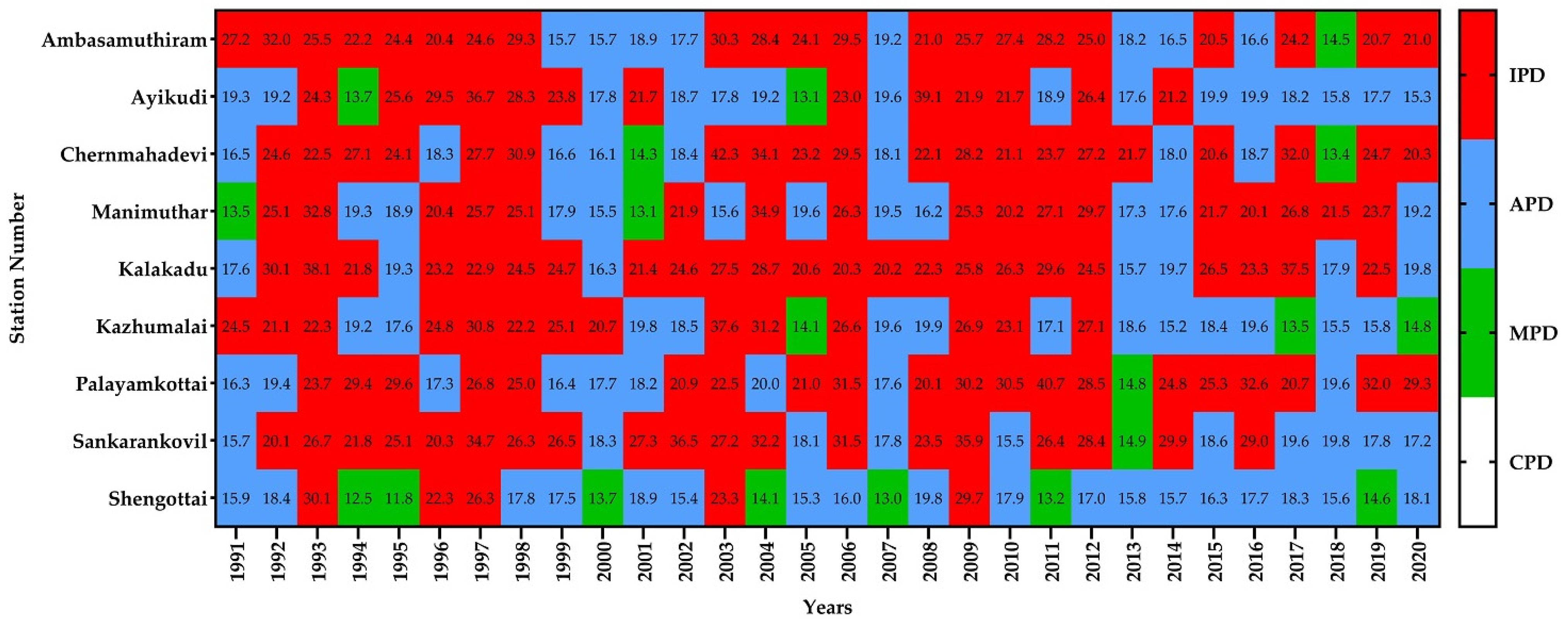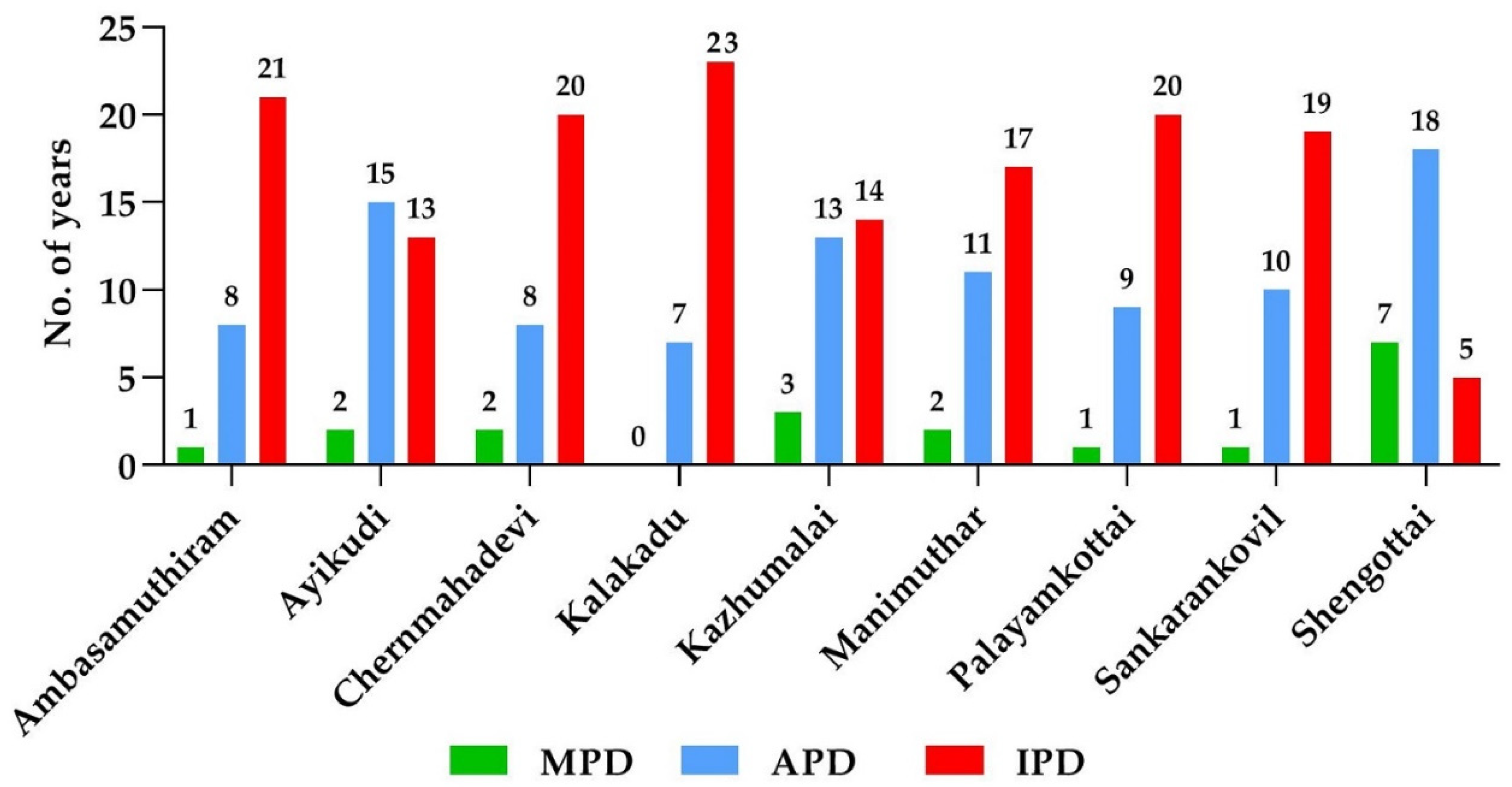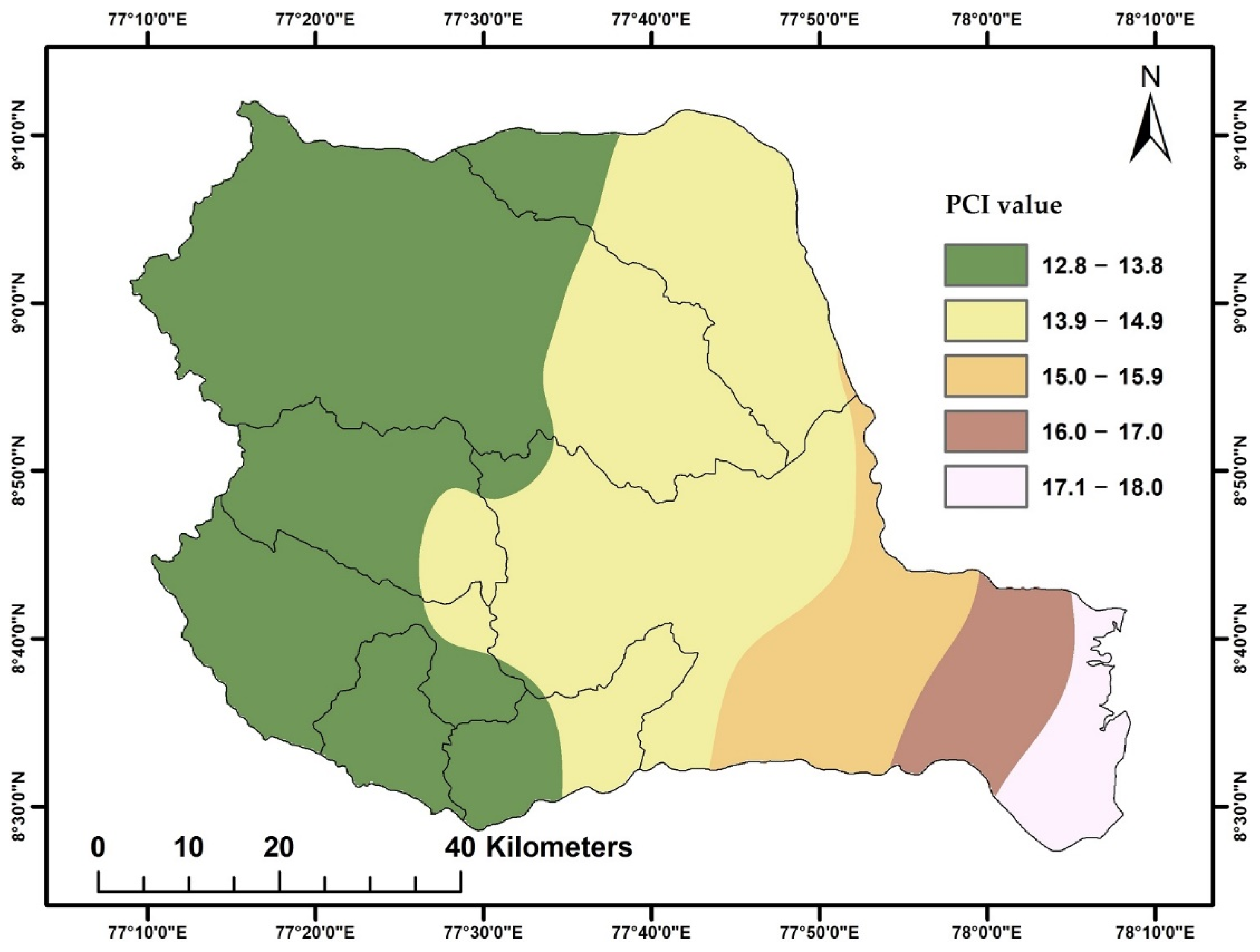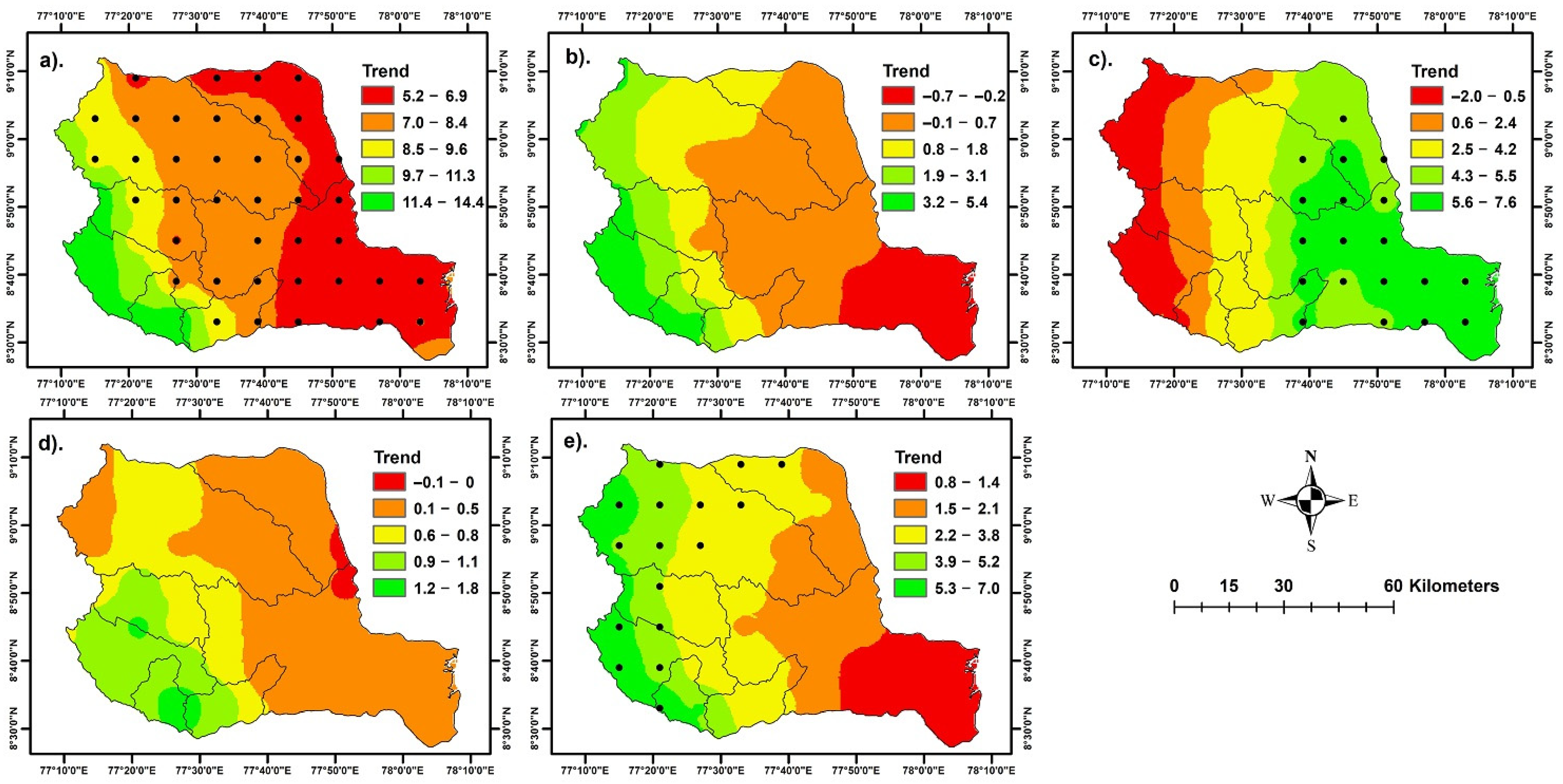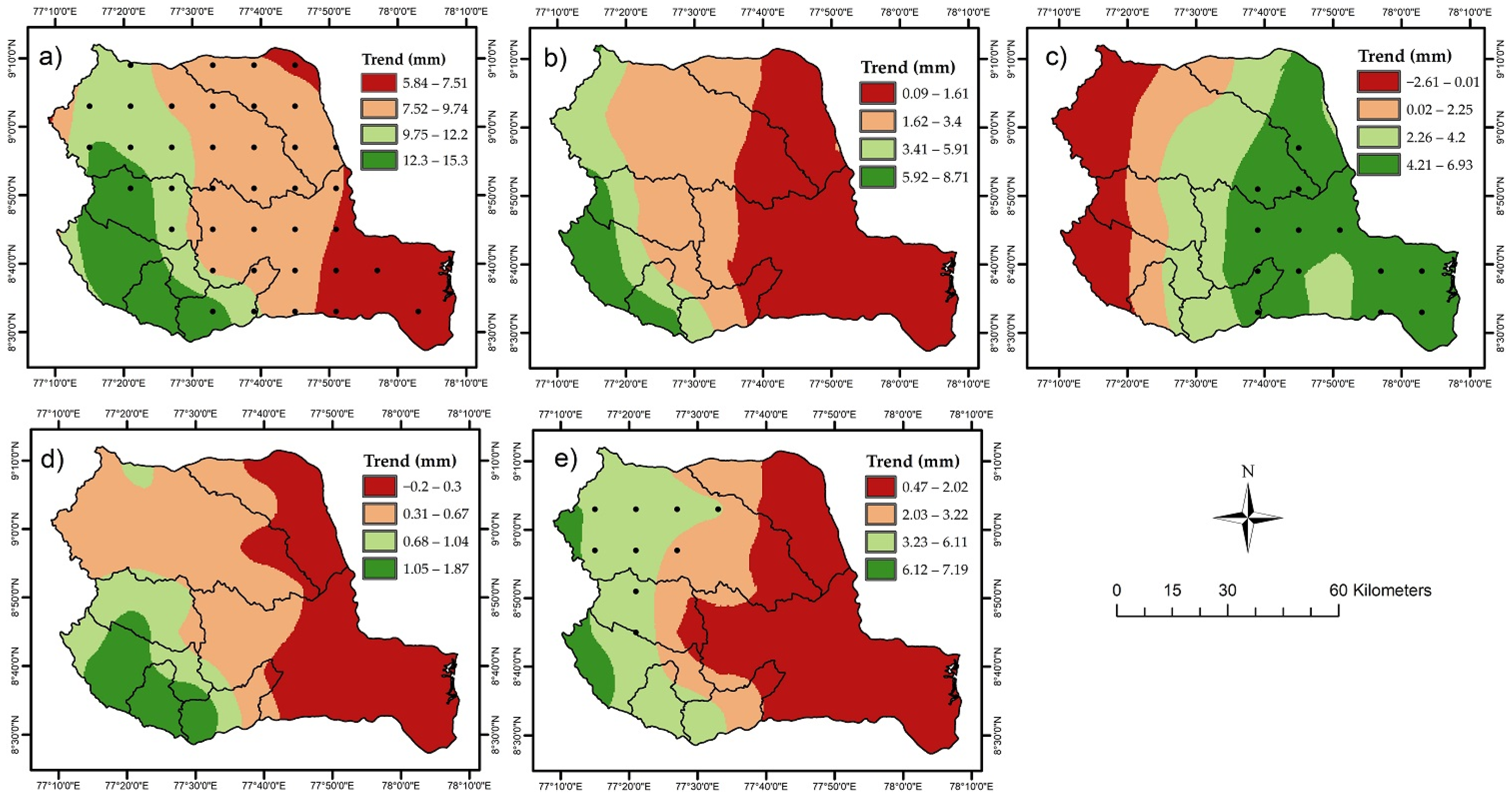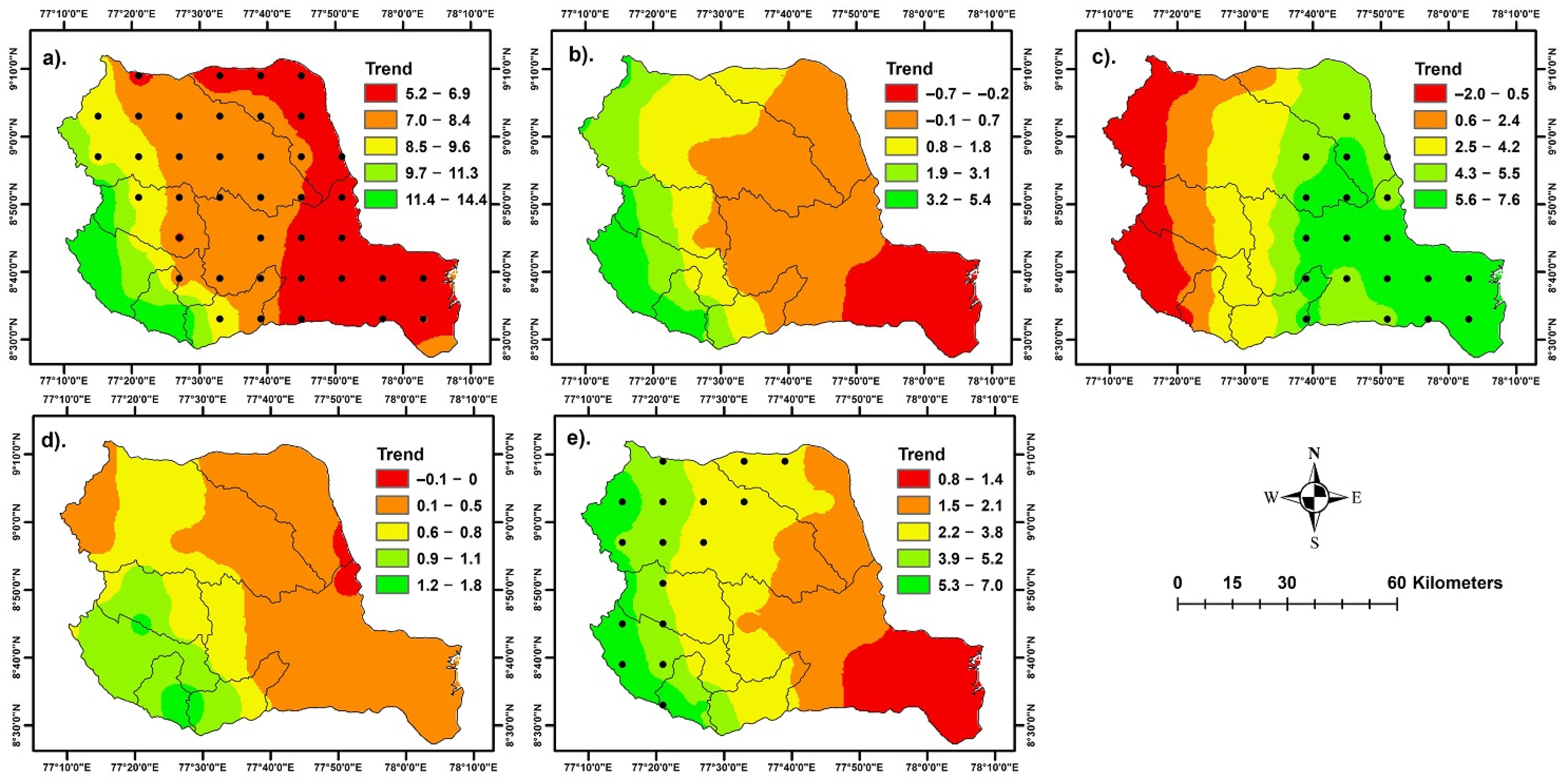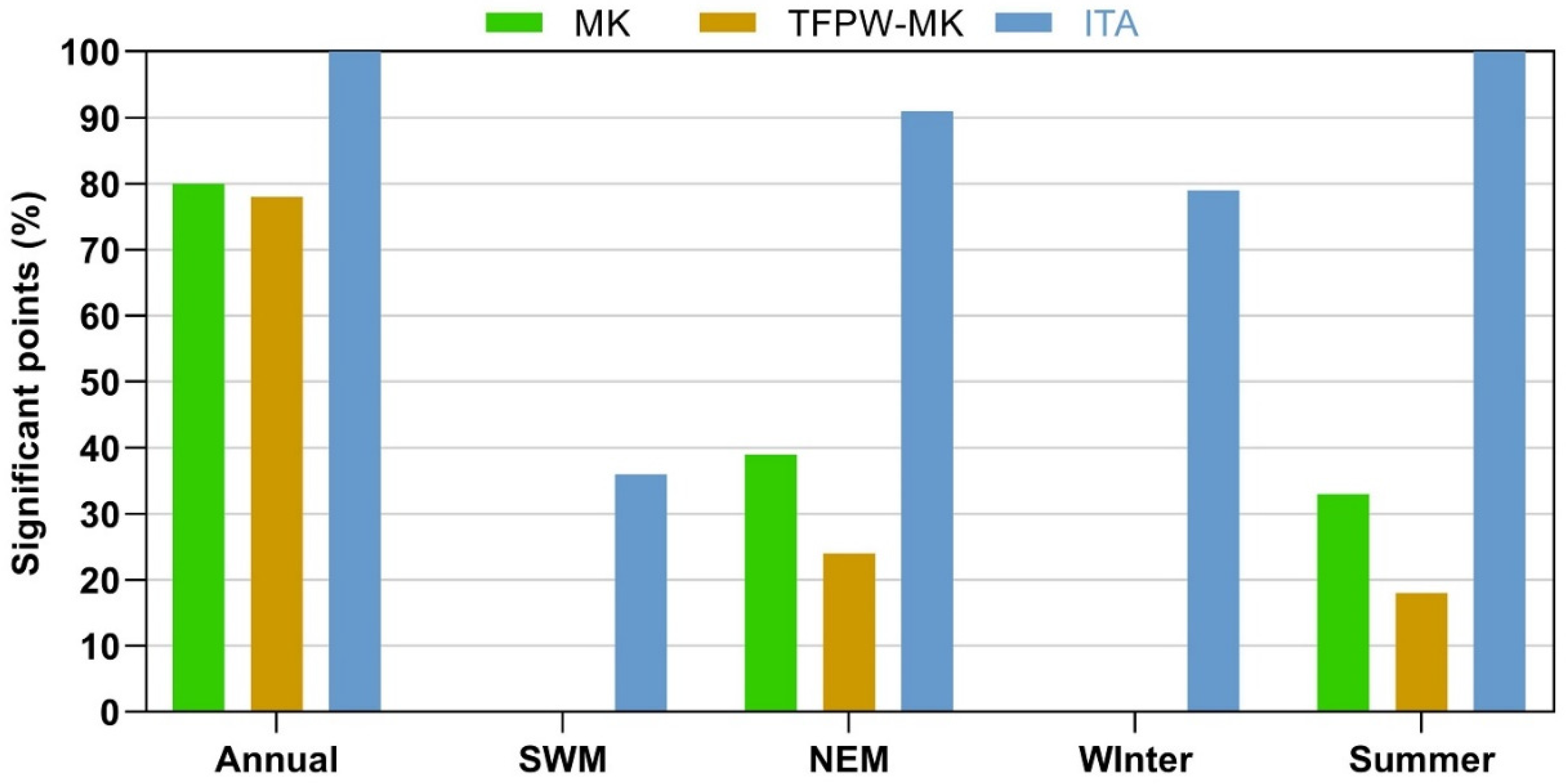1. Introduction
Rainfall is a pivotal component of the hydrological cycle, and variations in its pattern have a direct impact on the water supply [
1]. Climate change influences rainfall characteristics such as quantity, intensity, and seasonality, as well as the occurrence of drought and flood. Extreme rainfall events affect the seasonal or annual amount of precipitation [
2]. Lack of rainfall lowers reservoir water levels, decreases moisture content, reduces streamflow, and causes a depletion of the groundwater table [
3]. Changes in rainfall quantity and frequency have a direct impact on stream flow pattern and demand, spatiotemporal allocation of run-off [
4], groundwater reserves [
5,
6], and soil moisture [
7]. Understanding these changes has far-reaching implications for water resources, the environment, terrestrial ecosystems, the ocean, biodiversity, agriculture, and food security [
8].
Drought and floodlike hazards are frequently caused by extreme fluctuations in rainfall patterns. Drought is characterized by reduced or inadequate rainfall, which restricts plant development and eventually affects yields. Flooding is caused by a heavy downpour of rainfall, which deteriorates crop growth [
9,
10]. The impact of climatic extremes varies throughout geographical features and time, depending on agricultural practices, agroecology, and a farmer’s ability to adapt to those conditions [
11]. Changes in rainfall patterns also play a role in the emergence of new crop pests and diseases [
12,
13].
Rainfall has a significant role in determining water availability in an area. Analyzing precipitation characteristics and patterns is a critical task for improving water resource utilization and for practitioners engaged in water resource planning and making policy decisions [
14,
15]. The Intergovernmental Panel on Climate Change report (2008) also emphasized the growing importance of trend analysis in meteorological and hydrological data for detecting major changes induced by climate change [
16]. A dense network of meteorological stations is required for effectively defining the spatial trends of climatic variables. In remote areas, owing to limited spatial coverage of meteorological stations, satellite-based gridded products are used as an input for trend identification, modelling, statistical analysis, and other climatological applications [
17]. Several research works on gridded data have been conducted comparing and assessing the correlation between satellite-derived and observed data [
18,
19,
20]. Gridded satellite data were validated and applied in trend and variability analyses across many river basins [
21,
22,
23,
24]. Extensive studies have been carried out for various places throughout the world, examining the pattern, trends, and distribution of rain using station and satellite-gridded datasets [
25,
26,
27,
28].
Many methodologies in the parametric [
29,
30] and nonparametric tests [
31,
32] have been reported for assessing trends using gridded rainfall datasets. Among them, the Sen’s slope estimation [
33] and the Mann-Kendall (MK) test are the most often used nonparametric method for detecting trends in time series data [
34,
35,
36,
37,
38,
39,
40]. Recently, an innovative trend analysis (ITA), a graphical method, was widely used, and it does not need any assumptions in time series data [
5,
25,
33,
35,
41]. These nonparametric methods have several advantages, such as managing missing data and not requiring any assumptions [
42,
43]. The main drawback of these methods is the effect of autocorrelation on time series data, and to reduce this effect, many modifications have been proposed in the MK test [
44,
45,
46]. Studies in analyzing precipitation trends have been reported across the world in various river basins such as the Indus basin [
47], Vea catchment [
48], Awash River basin [
49], and Yarlung river basin [
40]. Similarly, in India, trend studies using gridded satellite products have been performed in the Kosi River basin [
50], the Cauvery basin [
51,
52,
53], and the Gomati basin [
54].
The Thamirabharani River originates in the Western Ghats; it is a perennial river that serves as a major source of water for agricultural and municipal needs in the southern districts of the Tamil Nadu [
55]. The majority of the basin’s upstream area and reservoirs are at high altitude and close to the Western Ghats. Rainfall variability caused by global warming affects inflow, outflow, and water discharge in the dam [
56], reducing agricultural production and negatively impacting areas that rely on dam water. Therefore, studying climate variability and trends may help the agriculture sector and government in effective water management planning. In a few studies, only rainfall trends were examined in the Thamirabharani basin [
57] and the Lower Thamirabharani sub-basin [
58] while no spatial scale study has been conducted in the basin. In the Thamirabharani basin, the distribution of gauge stations is quite sparse and also no rainfall stations have been located in the high elevated areas where the majority of the reservoirs are located, making it difficult to detect trends in isolated places. Hence, the current study was carried out to examine the spatial trend pattern and variability in rainfall over the Thamirabharani river basin using both gauge stations and satellite-gridded rainfall data and then to apply this information for appropriate agricultural planning.
2. Materials and Methods
Overall methodology is represented as a flowchart in
Figure 1 and the same is explained elaborately in the following subsections.
The Thamirabharani, a perennial river, originates from the Pothigai hills (Agastyarkoodam Peak) in the Western Ghats of Southern India. The entire river basin covers an area of approximately 5717.08 km
2 and is located in the Tenkasi, Tirunelveli, and Thoothukudi districts of Tamil Nadu. The river flows through 11 anicuts spread over three districts, with a total distance of 125 km [
55]. The entire basin is divided into seven sub-basins, with catchment areas found in Chittar, Gadananadhi, Manimuthar, Pachiyar, and Upper Thamirabharani, and some parts of Chittar, Lower Thamirabharani, and the Uppodai sub-basin located largely in low stream areas (
Figure 2). The basin area comprises three forms of natural features: dense forest in the high-altitude region, gentle agricultural areas, and low-lying coastal areas in the east [
59]. The general climatic pattern of the basin is subtropical type with an annual mean temperature ranging from 23 to 27 °C. The entire basin receives an average rainfall of 985.77 mm per year. Agriculture in this region depends on water released from dams, and the main crops cultivated include rice, sugarcane, bananas, groundnuts, and floriculture. The major crop-growing seasons are the Kharif and rabi season, which coincide with two monsoon rainfalls [
60].
2.1. Data Used
Ground level observed gauge station data was obtained from the India Meteorological Department (IMD). Data quality checking and validation were performed using the procedure described in [
61]. After quality assessment, only 9 stations with no missing data were chosen for research out of 15 gauge stations. For this study, rainfall data from the years 1991 to 2020 was used, and it was classified as annually, Southwest Monsoon (SWM) (June–September), Northeast Monsoon (NEM) or postmonsoon season (October–December), winter season (January–February), and summer season or premonsoon season (March–May) [
62]. The descriptive statistics of rainfall at nine gauge stations that include standard deviation, skewness, and kurtosis are presented in
Table 1. This indicates that mean rainfall of the annual and seasonal period exhibits both negative and positive values in skewness and kurtosis.
Figure 1 illustrates the location, Land-use and land cover, geographical location of rainfall gauge station, and elevation profile of the Thamirabharani river basin, whereas
Table 2 presents the details of the rainfall gauge stations.
The recently released Multisource Weighted Ensemble Precipitation (MSWEP) dataset with a 0.1° resolution was derived by merging gauge data, satellite, and reanalysis data and used for spatial analysis. This dataset includes bias-corrected climate mean data from the Climate Hazards Group Precipitation Climatology (CH-Pclim), stream flow data from the USGS Geospatial Attributes, PRISM climatic precipitation data, and global runoff data from the Global Runoff Data Centre (GRDC). Additionally, it includes various gridded satellite-based precipitation products, including TMPA 3B42RT, PERSIANN, CHIRPS, CMORPH, SM2RAIN-ASCAT, and GSMaPMV, as well as reanalysis datasets such as ERA-Interim, NCEP-CFSR, JRA-55, and many others [
63]. The methodology, accuracy, and quality assessment of the MSWEP product can be seen in [
64]. In India, MSWEP data are compared and validated with IMD data [
65,
66] and used in rainfall analysis [
21,
27,
32]. The statistical comparison of MSWEP-gridded data shows a relative absolute error of less than 1, indicating a good relation with gauge station data (
Table A1). These gridded data were analyzed and interpolated in ArcGIS 10.5 using the IDW and Kriging approach [
67].
2.2. Rainfall Analysis
Variability in rainfall was analyzed using Coefficient of variation (CV) and Precipitation Concentration Index (PCI).
2.2.1. Coefficient of Variation (CV)
To assess the variability of the rainfall in the study area, the coefficient of variation (CV) was used (see [
68] for more details). The level of variability depends on the indicator; thus, it follows that the higher the CV value, the higher the variability in rainfall and vice versa. It is expressed in percentage (%).
The value of CV was obtained by the above-described method and was used to categorize the degree of variability of rainfall events as low variability (CV < 20%), moderate variability (20 < CV < 30%), high variability (CV > 30%), very high variability (CV > 40%), and extremely high interannual variability of rainfall (CV > 70%) [
69].
2.2.2. Precipitation Concentration Index (PCI)
The PCI is a monthly rainfall distribution index derived from time series data that can be used to assess the seasonality of rainfall. It is calculated using the method described by Oliver [
70], and PCI values less than 10 indicate a consistent precipitation distribution, values 11 to 15 indicate a moderate precipitation concentration, and values 16 to 20 indicate an anomalous precipitation distribution. PCI values greater than 20 dramatically indicate an irregular precipitation distribution. PCI is calculated by the given equation
where
Pi is the quantity of rainfall on
ith month, used to calculate annual
PCI values.
2.3. Rainfall Trend Analysis
The trend in time series rainfall data was analyzed using the methods: i. Mann-Kendall test, ii. Sen’s slope estimator, iii. trend-free prewhitening Mann-Kendall test, and iv. innovative trend analysis (graphical method).
The Mann-Kendall (MK) trend test is a nonparametric, rank-based method for detecting significant monotonic trends in meteorological and hydrological data [
71,
72]. It has the advantage of not requiring any prerequisite conditions for the time series data to be normally distributed or the presence of a linear line or missing data values, etc. [
73]. To determine whether there is a uniform linear growth or fall tendency in the trend analysis, the MK test was first applied. Then, the linear trend was evaluated using the nonparametric Sen’s slope estimate, which provides a statistical (mm/year) representation of the increase or decrease in the rainfall under consideration [
74].
Historically, linear regression was the most commonly used method for trend identification, but it is parametric and needs data to be normally distributed. The MK test has been widely used in trend analysis due to its simplicity, flexibility to accept missing and non-normal data distributions, and ability to mitigate the impact of outliers and remove major data imperfections [
75]. Additionally, the MK test can be used for different time periods, including monthly, seasonal, and yearly.
where
In which
xj and
xi are the rainfall observations recorded at times
j and
i (with
j >
i), respectively, and
n is the length of the time series data. Under the null hypothesis (H
0) condition, the distribution of
S is symmetrical and normal in the limit as
n becomes large, with zero mean and variance:
where
ti indicates the number of ties with extend
i.
Finally, the statistic (
Zmk) for the given variance (
S) is calculated by Equation (5)
The positive (or negative) of Zmk from Equation (5) indicates the increasing (or decreasing) direction of the trend in the time series. In this study, data were employed for trend analysis at a 95% significance level and the null hypothesis for no trend in rainfall was rejected if Zmk was greater than 1.96.
2.3.1. Sen’s Slope Estimator
Sen’s slope estimation is a nonparametric method for calculating the magnitude of the trend in meteorological/hydrological time series data. It was computed using the method outlined by Sen [
73]. In a given time series data, a positive coefficient indicates an upward trend and vice versa.
The magnitude of the trend for a given time series, viz.,
x1, x2, x3,…,
xn rainfall data at time
t1,
t2,
t3,
…, tn (t1 < t2 < t3 < … < tn), for each N pairs of rainfall observations
xj and
xi taken at times
tj and
ti, the gradient (
Qk) can be calculated by the equation given below:
With 1
< i < j < n and
tj > ti. The trend estimates in the time series data
x1, x2, x3,…, xn can be calculated as the median
Qmed of the N values of
Qk, ranked from the smallest to the largest.
The positive (or negative) value of Qmed represents the increasing (or declining) trend and the zero value represents no trend in rainfall data.
2.3.2. Trend Free Prewhitening (TFPW)-Mann-Kendall Test
In order to eliminate the presence of serial correlation in time series rainfall data, prewhitening of the data is important [
76]. When the time series data are not random and influenced by autocorrelation, the trend factor is eliminated from the data and prewhitened before the trend test is applied [
77]. The linear trend component of the original time series data is removed and prewhitened using the lag-1 serial correlation coefficient. Finally, the prewhitened data is used to find the trend through the Mann-Kendall trend test [
78].
2.3.3. Innovative Trend Analysis (ITA)
The innovative trend analysis (ITA) method is a graphical trend analysis method that does not require any assumptions such as serial correlation, sample or population size, non-normality, and so on, which are required by traditional trend analysis methods (Mann-Kendall test, Spearman’s rho tests, cumulative sum, and so on). Trend graphs were generated using the method adopted and the procedures followed as per [
33,
41].
First, the time series is separated into two equal parts that are then sorted in ascending order individually. The first and second halves of the time series are then plotted on the X- and Y-axes, respectively. There is no trend in the time series if the data are accumulated on the 1:1 ideal line (45° line). If the data are in the top triangular section of the 1:1 ideal line, there is an increasing tendency in the time series. When data are gathered in the bottom triangular area of the 1:1 line, the time series shows a falling trend. The trend slope (TS) and significance were calculated as represented in [
79]. In this study, the ITA method was applied at 95% significance levels in time series rainfall data.
4. Discussion
Rainfall has both direct and indirect impacts on agricultural production. It is a critical element in deciding crop type, cropping pattern, and yields in rainfed areas. Water released from reservoirs is primarily responsible for agriculture and drinking water supply in the Thamirabharani river basin [
55]. Hence, characterizing the trend and variability of rainfall is important for sustainable crop planning and water management strategies [
81,
82]. Previous studies in the same basin [
57] and in the Lower Thamirabharani sub-basin [
58] used only station data and did not examine spatial pattern. Recently, ITA has been used in many studies due to its advantages over other trend analysis methodologies [
35]. From the highlighted gaps in the expertise, the current study was conducted to determine rainfall variability and trend using gauge station and satellite-gridded data.
The annual mean rainfall in gauge stations ranged from 666.1 to 1465.3 mm/year, with an overall average of 914.1 mm/year. Considering the seasonal average, the NEM got 545.4 mm of rain, followed by summer (165.8 mm) and the SWM (145.8 mm). NEM rainfall makes the most significant contribution (more than 59 per cent), followed by summer rainfall (18.1%), and SWM (16%). This is supported by a similar report by [
57,
83] in the Thamirabharani river basin and also in the Vellar basin [
84] and Lower Bhavani basin [
85] of Tamil Nadu, where NEM contributed major rainfall to the basin. NEM rainfall is ideal for agricultural activity throughout the rabi season. Summer rainfall determines premonsoon crop planning for the Kharif season; however, later crop cultivation and production are dependent on rainfall from the SWM in the Thamirabharani river basin [
86,
87]. The spatial pattern of mean annual rainfall spans from 744.36 to 2189.47 mm/year, with rainfall increasing from the low plains to the high-elevation zones in the western region. MSWEP data showed more rainfall than ground data, it has been observed that the catchments (highly elevated areas) receive more rainfall (
Figure 3), which might increase dam inflow and outflow and these regions that are located on the western side of the basin have largely deep forests and receive rainfall throughout the year [
88].
Variability in annual mean rainfall exhibits very high variability (CV greater than 40%) in all stations, except Ambasamuthiram (
Table 3), which could have an impact on the agricultural activity in the basin. A similar result was reported in the Thamirabharani basin [
57]. Seasonal rainfall in all stations experiences very high interannual variability (on average, more than 60% CV). Spatial variation of the CV on annual rainfall is low (12.8 to 20.1%) while seasonal rainfall has moderate to extremely high interannual variability. A similar report by [
88] also mentioned high to very high interannual variability of rainfall in the Western Ghats, which could be attributed to moisture supply by the lower tropospheric winds that govern rainfall activity over the Western Ghats [
89]. Low-lying coastal areas in the southeast part experience higher variability in annual and seasonal rainfall than other regions of the basin (
Figure 5). The spatial scale assessment aids in a better understanding of rainfall variability and its impacts on water availability [
46]. It is also necessary at the basin level for environmental impact studies, crop planning, and watershed management planning [
29,
45]. In rainfed agriculture, the seasonal unpredictability of rainfall has a substantial impact on crop productivity [
90,
91,
92]. PCI values show moderate to irregular monthly distribution of rainfall, whereas satellite data indicates a moderate distribution in the western half (
Figure 8) and an anomalous to irregular pattern of precipitation distribution in low plain and low-lying coastal areas of the basin. The precipitation concentration index is crucial for integrated water resource management, drought and flood risk identification, and environmental conservation [
93].
Rainfall trend analysis by MK, TFPW-MK, and ITA methods revealed heterogeneous results. Except for a few stations in the summer, the MK and TPFPW-MK trend analysis in gauge stations found no significant trend; however, in the ITA method, more than 60% of stations showed a significantly positive increase in rainfall (
Table A2 and
Table A3). The spatial pattern of the rainfall trend is given in
Figure 9,
Figure 10 and
Figure 11. The comparison of spatial annual and seasonal rainfall trends revealed that the rainfall trends for the SWM, winter and summer rainfall are similar to the annual trend, with the trend being higher in the western regions than in the low plains, particularly the Lower Thamirabharani sub-basin in the basin’s east. The low plain zones only show a statistically significant rising tendency. Meanwhile, the rising trend in summer rainfall does not affect annual rainfall because the western half of the basin experiences a statistically significant increase in summer rainfall, but the same region does not see significant increases in yearly precipitation. This overall observed trend is similar to research conducted over major rivers in India [
32]. The SWM does not show any significant rising tendency across the entire basin. During the NEM season, the low plains in the eastern part of the basin receive more rainfall and a significantly increased trend in the rainfall. Though the NEM is a major contributor of rainfall in the basin, especially the low plains areas might have intensive agriculture. It was also reported that the increase in rainfall during the NEM also increases the electrical conductivity and turbidity of water in the basin [
94]. The topography and monsoon activity both impact the rainfall pattern and trends in the Thamirabharani river basin [
82]. The percentage of significant points was higher in the ITA approach than with the other methods (
Figure 12). This confirms the research results that the ITA method has a greater advantage in detecting trends that the MK trend analysis did not detect [
29,
45]. However, the percentage of significant points was lesser in the trend-free prewhitening test, which might be due to the removal of serial correlation in the data.
Generally, spatiotemporal investigation of the seasonal contribution of rainfall in annual rainfall indicated that small regions in the basin’s western part have a significant rising trend in the summer. A significant upward trend was observed during the NEM over the central and southeast part of the basin, including the Lower Thamirabharani sub-basin. However, except during the NEM, the contribution of other seasonal trends to annual precipitation does not show a significant trend. Moreover, the results show that the contribution of each season to total annual rainfall varies between seasons in some parts of the basin. The results indicate that rainfall that occurs over the central, eastern, and southeast regions of the Thamirabharani basin during the NEM season, especially in the months of October, November, and December, could decrease in catchment areas and increase in the low plains of the basin.
